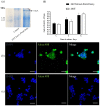Myxococcus xanthus Encapsulin as a Promising Platform for Intracellular Protein Delivery
- PMID: 36555233
- PMCID: PMC9778880
- DOI: 10.3390/ijms232415591
Myxococcus xanthus Encapsulin as a Promising Platform for Intracellular Protein Delivery
Abstract
Introducing a new genetically encoded material containing a photoactivatable label as a model cargo protein, based on Myxococcus xanthus (Mx) encapsulin system stably expressed in human 293T cells. Encapsulin from Mx is known to be a protein-based container for a ferritin-like cargo in its shell which could be replaced with an exogenous cargo protein, resulting in a modified encapsulin system. We replaced Mx natural cargo with a foreign photoactivatable mCherry (PAmCherry) fluorescent protein and isolated encapsulins, containing PAmCherry, from 293T cells. Isolated Mx encapsulin shells containing photoactivatable label can be internalized by macrophages, wherein the PAmCherry fluorescent signal remains clearly visible. We believe that a genetically encoded nanocarrier system obtained in this study, can be used as a platform for controllable delivery of protein/peptide therapeutics in vitro.
Keywords: encapsulins; fluorescence; photoactivatable label; protein delivery.
Conflict of interest statement
The authors declare no conflict of interest.
Figures




References
-
- Akash M.S.H., Rehman K., Chen S. Pluronic F127-Based Thermosensitive Gels for Delivery of Therapeutic Proteins and Peptides. Polym. Rev. 2014;54:573–597. doi: 10.1080/15583724.2014.927885. - DOI
MeSH terms
Substances
Grants and funding
LinkOut - more resources
Full Text Sources

